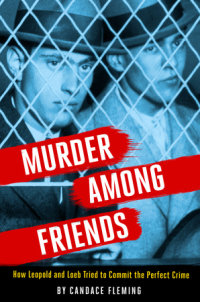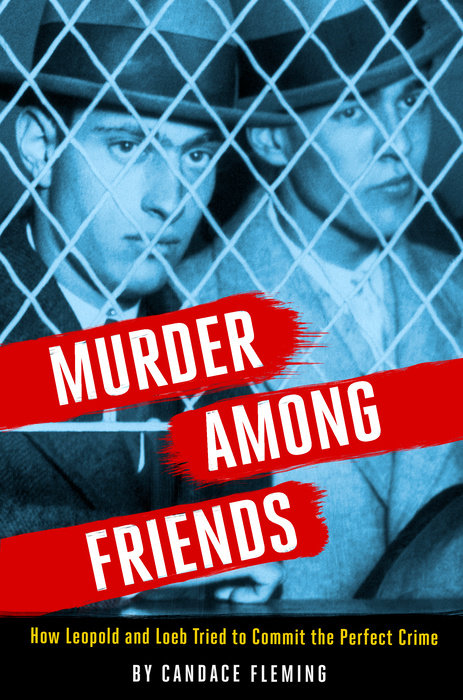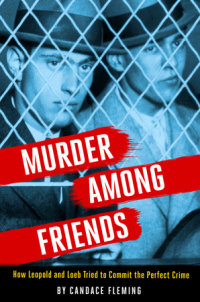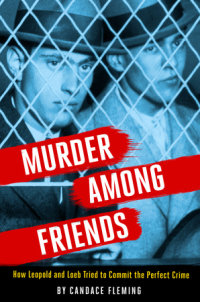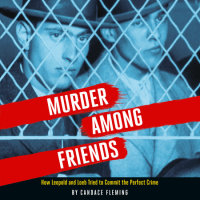Murder Among Friends
How did two teenagers brutally murder an innocent child...and why? And how did their brilliant lawyer save them from the death penalty in 1920s Chicago? Written by a prolific master of narrative nonfiction, this is a compulsively readable true-crime story based on an event dubbed the "crime of the century."
In 1924, eighteen-year-old college students Nathan Leopold and Richard Loeb made a decision: they would commit the perfect crime by kidnapping and murdering a child they both knew. But they made one crucial error: as they were disposing of the body of young Bobby Franks, whom they had bludgeoned to death, Nathan's eyeglasses fell from his jacket pocket.
Multi-award-winning author Candace Fleming depicts every twist and turn of this harrowing case--how two wealthy, brilliant young men planned and committed what became known as the crime of the century, how they were caught, why they confessed, and how the renowned criminal defense attorney Clarence Darrow enabled them to avoid the death penalty.
Following on the success of such books as The Rise and Fall of Charles Lindbergh and The Family Romanov, this acclaimed nonfiction writer brings to heart-stopping life one of the most notorious crimes in our country's history.
An Excerpt fromMurder Among Friends
Part One
Where
Is Bobby?
Chapter One
Wednesday, May 21, 1924
Nineteen-year-old Nathan Leopold would kill a child today. He didn’t expect to get much pleasure from it. Still, it would be an interesting intellectual experiment, like an entomologist sticking a pin through a beetle. Besides, his friend Richard wanted this murder . . . badly. And Nathan would do anything for Richard Loeb.
Nathan lit a cigarette and looked over at Richard. The eighteen-year-old appeared calm as he drove the rental car. But Nathan could see a muscle in Richard’s right cheek twitching. He knew that sign. Richard was ready, eager even, to kill somebody.
On the floor of the backseat, wrapped in a blanket, lay their gear—rope, chisel, adhesive tape, gags, hydrochloric acid, and hip boots. They had everything they needed. Everything but a victim.
Nathan looked at his watch.
Two-thirty.
School was letting out.
The pair drove into their Chicago neighborhood of Kenwood, a little pocket of fashionable homes on the city’s South Side. A street away from the Harvard School for Boys, Richard pulled to the curb. He turned off the ignition. They sat there. Who should they grab? They hadn’t settled on a specific victim. Any boy would do.
Leaving Nathan in the car, Richard walked to the school. Kids poured out onto the playground. He noticed nine-year-old Johnny Levinson, who was in the same fourth-grade class as Richard’s little brother, Tommy. Just days earlier, the boy had played at the Loeb house.
There couldn’t be a better victim. Stick thin and small for his age, Johnny would be easy to nab.
Richard turned on his charm. “What are you doing after school?” he asked Johnny in his friendliest voice.
“I’m going to play baseball,” replied Johnny.
Where? Richard wanted to know. Who with?
It was just a pickup game with some friends, Johnny told him. He was headed over to the vacant lot at 49th Street and Drexel.
Richard wondered how to lure the boy to the car. Should he offer him a ride?
But before he got the chance, Johnny ran off.
Frustrated, Richard walked around to the front of the school. He saw Tommy standing on the steps. Maybe he should grab him.
Just then Nathan whistled for Richard to return to the car. When he did, Nathan said, “There are some children playing on Ingleside Avenue.” Maybe they could catch one of them.
Richard had a better idea. Why not go over to the vacant lot on 49th Street and watch Johnny’s baseball game? They could snatch the boy afterward as he was walking home.
Nathan agreed. They drove toward the lot. Yes, the boys were there. But from the moving vehicle, Richard and Nathan couldn’t recognize anybody. They parked again, a block from the lot, and walked down an alley to a spot where they could see the game. Still, they couldn’t make out faces. Could they get closer? Not without being seen. And they couldn’t let that happen. When Johnny vanished, the police would put two and two together. No, they’d have to watch the boy from a distance. To do that, they needed Nathan’s field glasses.
It was only four blocks to the Leopolds’ house. After dropping Nathan off, Richard drove to a nearby drugstore. He bought two packages of gum before heading to the phone booth in the back to look up Johnny’s address in the telephone book. Chewing away, Richard flipped through the pages until he found it. He nodded. He now knew the route Johnny would take to walk home.
Minutes later, he picked Nathan up. They returned to the alley near the vacant lot. Passing the field glasses back and forth, they watched the children play. Nathan pointed out a few other possible victims. What about the shortstop, or the kid on third base? Richard nixed those ideas. He had his heart set on killing Johnny.
At four-thirty, Johnny and some others suddenly walked away from the game. Richard grew worried. Was Johnny coming back? He and Nathan waited, but there was no further sign of the boy.
They drove around and around the neighborhood.
Who knew it would be so hard to nab a child?
Nathan looked at his watch again. It was getting late, almost dinnertime. They’d been searching for a victim for more than two hours. He suggested they try again tomorrow.
Richard refused. They’d been planning this for so long. They couldn’t quit. Not yet. One more time around the neighborhood, he insisted.
This time, Nathan drove. They passed by the vacant lot again. They went by the Levinson house, too.
No luck.
That was when they saw him, walking on the opposite side of the street all by himself. He wore a tan jacket, knickers, wool golf stockings with checkered tops, a necktie, and a tan cap.
“I know him,” said Richard.
It was his second cousin, fourteen-year-old Bobby Franks. Bobby lived across the street from Richard. Just yesterday they’d played tennis together on the Loebs’ court.
The car passed the boy. Richard signaled for Nathan to turn around and drive up behind him. As Nathan did, Richard climbed in back, behind the front passenger seat.
The car pulled up alongside Bobby.
“Hey, Bob,” Richard called. He leaned forward and opened the passenger door. “Do you want a ride home?”
Bobby shook his head. His house was only two blocks away.
“Come on in,” urged Richard. “I want to talk to you about the tennis racket you had yesterday. I want to get one for my brother.”
Bobby moved closer to the car. He was so close Richard could have grabbed him and dragged him in. Instead, he kept talking, kept smiling.
Bobby hesitated a moment longer. Then he slid into the front passenger seat. He looked over at Nathan.
“You know Leopold, don’t you?” said Richard.
Bobby didn’t. He turned around to the backseat, eager to talk tennis with his older cousin.
“You don’t mind [us] taking you around the block?” Richard asked.
“Certainly not,” said Bobby.
Nathan pulled away from the curb as Richard groped around on the floor for the chisel.
